#Nvidia Jetson
Explore tagged Tumblr posts
Text

NVIDIA Jetson in 2025: What You Need To Know
Explore the latest advancements in NVIDIA Jetson in 2025. Discover new features, performance upgrades, and how it's shaping the future of AI and edge computing.
0 notes
Text
Anton R Gordon’s Blueprint for Real-Time Streaming AI: Kinesis, Flink, and On-Device Deployment at Scale
In the era of intelligent automation, real-time AI is no longer a luxury—it’s a necessity. From fraud detection to supply chain optimization, organizations rely on high-throughput, low-latency systems to power decisions as data arrives. Anton R Gordon, an expert in scalable AI infrastructure and streaming architecture, has pioneered a blueprint that fuses Amazon Kinesis, Apache Flink, and on-device machine learning to deliver real-time AI performance with reliability, scalability, and security.
This article explores Gordon’s technical strategy for enabling AI-powered event processing pipelines in production, drawing on cloud-native technologies and edge deployments to meet enterprise-grade demands.
The Case for Streaming AI at Scale
Traditional batch data pipelines can’t support dynamic workloads such as fraud detection, anomaly monitoring, or recommendation engines in real-time. Anton R Gordon's architecture addresses this gap by combining:
Kinesis Data Streams for scalable, durable ingestion.
Apache Flink for complex event processing (CEP) and model inference.
Edge inference runtimes for latency-sensitive deployments (e.g., manufacturing or retail IoT).
This trio enables businesses to execute real-time AI pipelines that ingest, process, and act on data instantly, even in disconnected or bandwidth-constrained environments.
Real-Time Data Ingestion with Amazon Kinesis
At the ingestion layer, Gordon uses Amazon Kinesis Data Streams to collect data from sensors, applications, and APIs. Kinesis is chosen for:
High availability across multiple AZs.
Native integration with AWS Lambda, Firehose, and Flink.
Support for shard-based scaling—enabling millions of records per second.
Kinesis is responsible for normalizing raw data and buffering it for downstream consumption. Anton emphasizes the use of data partitioning and sequencing strategies to ensure downstream applications maintain order and performance.
Complex Stream Processing with Apache Flink
Apache Flink is the workhorse of Gordon’s streaming stack. Deployed via Amazon Kinesis Data Analytics (KDA) or self-managed ECS/EKS clusters, Flink allows for:
Stateful stream processing using keyed aggregations.
Windowed analytics (sliding, tumbling, session windows).
ML model inference embedded in UDFs or side-output streams.
Anton R Gordon’s implementation involves deploying TensorFlow Lite or ONNX models within Flink jobs or calling SageMaker endpoints for real-time predictions. He also uses savepoints and checkpoints for fault tolerance and performance tuning.
On-Device Deployment for Edge AI
Not all use cases can wait for roundtrips to the cloud. For industrial automation, retail, and automotive, Gordon extends the pipeline with on-device inference using NVIDIA Jetson, AWS IoT Greengrass, or Coral TPU. These edge devices:
Consume model updates via MQTT or AWS IoT.
Perform low-latency inference directly on sensor input.
Reconnect to central pipelines for data aggregation and model retraining.
Anton stresses the importance of model quantization, pruning, and conversion (e.g., TFLite or TensorRT) to deploy compact, power-efficient models on constrained devices.
Monitoring, Security & Scalability
To manage the entire lifecycle, Gordon integrates:
AWS CloudWatch and Prometheus/Grafana for observability.
IAM and KMS for secure role-based access and encryption.
Flink Autoscaling and Kinesis shard expansion to handle traffic surges.
Conclusion
Anton R Gordon’s real-time streaming AI architecture is a production-ready, scalable framework for ingesting, analyzing, and acting on data in milliseconds. By combining Kinesis, Flink, and edge deployments, he enables AI applications that are not only fast—but smart, secure, and cost-efficient. This blueprint is ideal for businesses looking to modernize their data workflows and unlock the true potential of real-time intelligence.
0 notes
Text
Vention stellt KI-gestützte Bin-Picking-Technologie vor - Live auf der NVIDIA GTC 2025
SAN JOSÉ, Kalifornien, 18. März 2025 /PRNewswire/ — Vention, Entwickler der weltweit einzigen Full-Stack-Software- und Hardware-Automatisierungsplattform, präsentiert seine KI-gestützte Bin-Picking-Technologie erstmals auf der NVIDIA GTC, der weltweit führenden Entwicklerkonferenz für Künstliche Intelligenz (KI). Dieses neue, KI-gesteuerte Verfahren ersetzt aufwendige und kostenintensive…

View On WordPress
#2025#ABB#AI#AI-Controller#BinPicking#Etienne Lacroix#KI#Künstliche Intelligenz#MachineMotion#NVIDIA GTC#Nvidia Jetson#Vention
0 notes
Text

The Nvidia Jetson Orin Nano looks like a computer now.
0 notes
Text
I'm a dumbass
I have a Turing Pi V2 with a Jetson Nano and it's the bees knees but I wanted to clear out some space, so I removed the graphical environment and other packages from Linux4Tegra (which is what NVIDIA offers, basically repackaged Ubuntu 18 LTS with their drivers and facilities, which have been historically NVIDIA's weak point in Linux land).
But the tutorial says "remove network-manager and then reinstall it", and I thought "well, I'll follow the tutorial", foolishly unaware that I had disabled dhcpd earlier in the week due to another issue, so I had no backup.
I came down from 92% usage to 60% which is all fine and dandy but I lost the machine. I can't SSH to it now.
I reinstalled network manager but even so, the machine didn't come back up on the network after reboot, so now I'm going to have to reflash the OS on the machine, which is a pain. NVIDIA's support is a joke.
Funnily enough, the machine does boot and it does prompt me to login if I hook up a monitor to it, but for some God forsaken reason it is not possible to use USB keyboards on the Turing Pi V2 for Jetson Nanos due to a limitation. If I had some way to actually login, I could easily fix this problem by re-enabling dhcpd.
0 notes
Text
Nvidia’s Jetson Thor: The Future of Humanoid Robots Arrives in 2025
Nvidia’s Jetson Thor is more than just a computing platform—it’s a breakthrough in humanoid robotics. By enabling robots to think, learn, and interact with humans in real-time, it is set to transform multiple industries.
How Nvidia’s New AI-Powered Computing Platform is Revolutionizing Robotics Nvidia is once again pushing the boundaries of artificial intelligence and robotics with its latest innovation—Jetson Thor. Set to launch in the first half of 2025, this advanced computing platform is designed to enhance humanoid robots, making them more autonomous and capable of real-world interactions. As part of…
#advanced computing#and real-time decision-making#Nvidia’s Jetson Thor revolutionizes humanoid robots with AI#set for 2025 launch.
0 notes
Text
Transforming Vision Technology with Hellbender
In today's technology-driven world, vision systems are pivotal across numerous industries. Hellbender, a pioneer in innovative technology solutions, is leading the charge in this field. This article delves into the remarkable advancements and applications of vision technology, spotlighting key components such as the Raspberry Pi Camera, Edge Computing Camera, Raspberry Pi Camera Module, Raspberry Pi Thermal Camera, Nvidia Jetson Computer Vision, and Vision Systems for Manufacturing.

Unleashing Potential with the Raspberry Pi Camera
The Raspberry Pi Camera is a powerful tool widely used by hobbyists and professionals alike. Its affordability and user-friendliness have made it a favorite for DIY projects and educational purposes. Yet, its applications extend far beyond these basic uses.
The Raspberry Pi Camera is incredibly adaptable, finding uses in security systems, time-lapse photography, and wildlife monitoring. Its capability to capture high-definition images and videos makes it an essential component for numerous innovative projects.
Revolutionizing Real-Time Data with Edge Computing Camera
As real-time data processing becomes more crucial, the Edge Computing Camera stands out as a game-changer. Unlike traditional cameras that rely on centralized data processing, edge computing cameras process data at the source, significantly reducing latency and bandwidth usage. This is vital for applications needing immediate response times, such as autonomous vehicles and industrial automation.
Hellbender's edge computing cameras offer exceptional performance and reliability. These cameras are equipped to handle complex algorithms and data processing tasks, enabling advanced functionalities like object detection, facial recognition, and anomaly detection. By processing data locally, these cameras enhance the efficiency and effectiveness of vision systems across various industries.
Enhancing Projects with the Raspberry Pi Camera Module
The Raspberry Pi Camera Module enhances the Raspberry Pi ecosystem with its compact and powerful design. This module integrates seamlessly with Raspberry Pi boards, making it easy to add vision capabilities to projects. Whether for prototyping, research, or production, the Raspberry Pi Camera Module provides flexibility and performance.
With different models available, including the standard camera module and the high-quality camera, users can select the best option for their specific needs. The high-quality camera offers improved resolution and low-light performance, making it suitable for professional applications. This versatility makes the Raspberry Pi Camera Module a crucial tool for developers and engineers.
Harnessing Thermal Imaging with the Raspberry Pi Thermal Camera
Thermal imaging is becoming increasingly vital in various sectors, from industrial maintenance to healthcare. The Raspberry Pi Thermal Camera combines the Raspberry Pi platform with thermal imaging capabilities, providing an affordable solution for thermal analysis.
This camera is used for monitoring electrical systems for overheating, detecting heat leaks in buildings, and performing non-invasive medical diagnostics. The ability to visualize temperature differences in real-time offers new opportunities for preventive maintenance and safety measures. Hellbender’s thermal camera solutions ensure accurate and reliable thermal imaging, empowering users to make informed decisions.
Advancing AI with Nvidia Jetson Computer Vision
The Nvidia Jetson platform has revolutionized AI-powered vision systems. The Nvidia Jetson Computer Vision capabilities are transforming industries by enabling sophisticated machine learning and computer vision applications. Hellbender leverages this powerful platform to develop cutting-edge solutions that expand the possibilities of vision technology.
Jetson-powered vision systems are employed in autonomous machines, robotics, and smart cities. These systems can process vast amounts of data in real-time, making them ideal for applications requiring high accuracy and speed. By integrating Nvidia Jetson technology, Hellbender creates vision systems that are both powerful and efficient, driving innovation across multiple sectors.
Optimizing Production with Vision Systems for Manufacturing
In the manufacturing industry, vision systems are essential for ensuring quality and efficiency. Hellbender's Vision Systems for Manufacturing are designed to meet the high demands of modern production environments. These systems use advanced imaging and processing techniques to inspect products, monitor processes, and optimize operations.
One major advantage of vision systems in manufacturing is their ability to detect defects and inconsistencies that may be invisible to the human eye. This capability helps maintain high-quality standards and reduces waste. Additionally, vision systems can automate repetitive tasks, allowing human resources to focus on more complex and strategic activities.
Conclusion
Hellbender’s dedication to advancing vision technology is clear in their diverse range of solutions. From the versatile Raspberry Pi Camera and the innovative Edge Computing Camera to the powerful Nvidia Jetson Computer Vision and robust Vision Systems for Manufacturing, Hellbender continues to lead in technological innovation. By providing reliable, efficient, and cutting-edge solutions, Hellbender is helping industries harness the power of vision technology to achieve greater efficiency, accuracy, and productivity. As technology continues to evolve, the integration of these advanced systems will open up new possibilities and drive further advancements across various fields.
#Vision Systems For Manufacturing#Nvidia Jetson Computer Vision#Raspberry Pi Thermal Camera#Raspberry Pi Camera Module#Edge Computing Camera#Raspberry Pi Camera
0 notes
Text

A pesar de la enorme potencia de la supercomputadora, es tan compacta que cabe en la palma de la mano.
Te presentamos sus innovadoras características:
2 notes
·
View notes
Photo
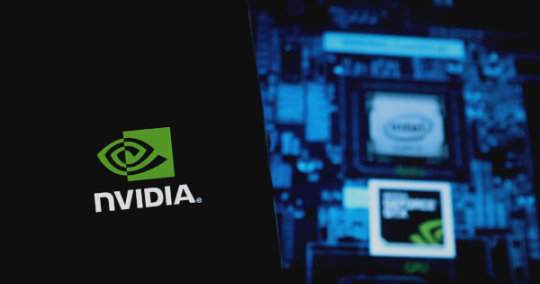
NVIDIA Expands Support for Google DeepMind's Gemma 3n on RTX and Jetson
0 notes
Link
🚀 From Cars to Factory Floors: How GPUs Are Driving the Future of Edge AI
Explore the cutting-edge world of embedded GPUs in autonomous vehicles, smart factories, and AI-powered edge devices. This in-depth blog covers everything from NVIDIA DRIVE for self-driving cars to Jetson Nano & Xavier for small-form-factor AI, GPU-accelerated 5G base stations, and real-world use cases in robotics.
Whether you're into AI hardware, edge computing, or automotive tech, this 4000+ word guide delivers insights, benchmarks, and future trends.
📲 Tap the link and power up your edge intelligence
#EdgeAI#AutonomousVehicles#GPUs#SmartFactory#EmbeddedAI#JetsonXavier#NVIDIAJetson#EdgeComputing#AIHardware#TumblrTech
0 notes
Text
BIOSTAR introduces new AI-NONXS Developer Kit that augments edge AI applications for modern deployment
BIOSTAR has just rolled out its AI-NONXS Developer Kit, a powerful edge AI platform designed for developers and system integrators looking to build and deploy AI-driven solutions at the edge. Supporting NVIDIA Jetson Orin NX and Orin Nano modules, this compact industrial-grade kit is aimed squarely at enabling next-gen AI capabilities in sectors like smart manufacturing, retail, transportation,…

View On WordPress
0 notes
Text
#AAEON#JetsonAI#EdgeComputing#SmartCity#NVIDIA#GTCParis#AIInnovation#TechShowcase#powerelectronics#powersemiconductor#powermanagement
0 notes
Text
#AAEON#robotics#NVIDIAJetson#AIoT#EdgeAI#SmartCities#Robotics#NVIDIAGTC#TimesTech#electronicsnews#technologynews
0 notes
Text
Automatica 2025: Vention erweitert Angebot mit Robotiklösungen von Franka Robotics
MÜNCHEN, 17. Juni 2025 /PRNewswire/ — Vention, Anbieter der weltweit einzigen vollständig integrierten Software- und Hardware-Plattform für industrielle Automatisierung, erweitert sein Robotik-Portfolio um kollaborative Roboter der Franka Robotics GmbH, einer Tochtergesellschaft der in München ansässigen Agile Robots SE. Vention hat sein Roboterangebot um kollaborative Roboter der Franka…

View On WordPress
#2025#ABB#ABB GoFa CRB 15000#Agile Robots#automatica#Bin-Picking#Fanuc#FR3#Franka Robotics#KI#MachineMotion#Nvidia#Nvidia Jetson Computing#Unviersal Robots#Vention
0 notes
Photo
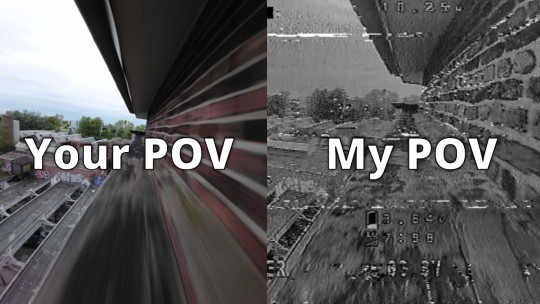
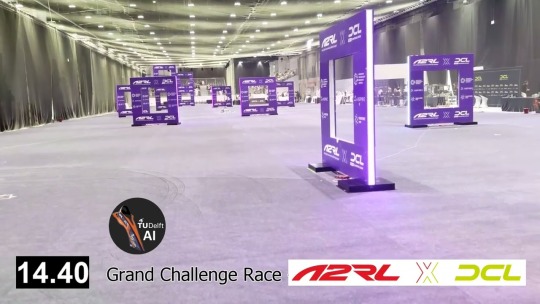
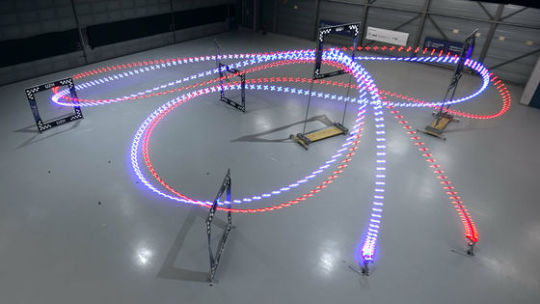
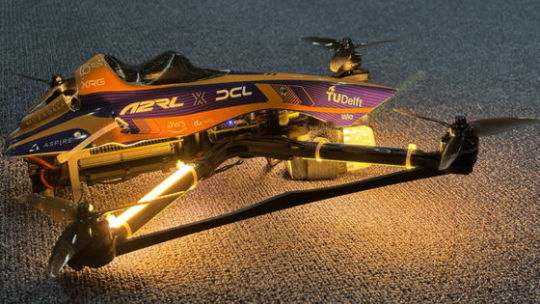

2025年06月10日 22時00分 AI操作の自律型ドローンが国際レースで初めて人間のチャンピオンに勝利、人間と同じたった1つのカメラで飛行
オランダの国立大学であるデルフト工科大学の研究チームが開発した自律型ドローンが、アラブ首長国連邦の首都アブダビで開催されたドローンレースで優勝しました。レースにおいて、デルフト工科大学の自律型ドローンは世界最高レベルのドローン操縦士が操作するドローンの成績を上回っています。
Autonomous drone from TU Delft defeats human champions in historic racing first https://www.tudelft.nl/en/2025/lr/autonomous-drone-from-tu-delft-defeats-human-champions-in-historic-racing-first
アラブ首長国連邦を先進技術の世界的リーダーとするため発足されたアブダビ先端技術研究評議会(ATRC)の一部門で、自動運転技術の限界に挑戦するアブダビ自律走行レーシングリーグ(A2RL)は、プロのドローンレースチームが参加する世界最大規模のドローンレースであるDrone Champions League(DCL)と提携し、中東初の「A2RL×DCL自動運転ドローン選手権」を開催しました。
このドローン選手権では、人間のパイロットによるドローンレース「Falcon Cup」と、AI搭載の自律型ドローンによるレース「A2RLドローンチャンピオンシップ」が開催されました。Falcon Cupで優勝したのは日本初のプロドローンレースチームである「RAIDEN RACING」です。
デルフト工科大学の開発したAIドローンは、まずA2RLドローンチャンピオンシップで優勝。��の後、人間のパイロットとのノックアウトトーナメントに出場し、優勝しました。ノックアウトトーナメントでは元DCLの世界チャンピオン3人を破って優勝しています。
レースで使用されたドローンはすべてNVIDIA Jetson AGX Orin、前方カメラ、オンボード知覚・制御用の慣性計測装置(IMU)を搭載した、標準化されたものです。
このドローン選手権では物理的なAIの限界に挑戦するため、参加ドローンに対して「1台のカメラのみを使用」という制約を課しており、この点が従来の自律型ドローンによるレースとの大きな違いです。前方を監視するためのカメラが1台だけ搭載されているというのは、人間のFPV(一人称)パイロットの飛行方法に非常に近いため、AIにとっては周囲環境を認識する上で非常に困難になります。
デルフト工科大学のドローンは、ディープラーニングによる高性能制御を実現することで、13機の自律型ドローンおよびドローンレースのチャンピオンが操縦する「人間が操作するドローン」に勝利しました。デルフト工科大学のドローンレースチームによると、AIドローンは曲がりくねったコースで最高時速95.8kmを記録したそうです。
デルフト工科大学のドローンチームは、「瞬時に高性能な制御を可能とする効率的で堅牢なAIシステムを開発することで、この偉業を達成した」と報告しています。AIがチェスや囲碁の世界チャンピオンを破るという画期的な出来事は主に仮想空間の中で起きていましたが、現実世界で「AIがドローンの世界チャンピオンを打ち破る」という結果は、大きな偉業といえます。
なお、チューリッヒ大学のロボティクス&パーセプショングループが2023年に人間の操縦士が参加するドローンレースで初めて自律型ドローンの勝利を記録しましたが、これは「飛行実験室」で実施されたレースであり、状況・ハードウェア・コースはすべて研究者が管理しています。一方、デルフト工科大学のAIドローンはハードウェアおよびコースが大会主催者によって完全に設計・管理されているという点で、状況が大きく異なります。
AIが操縦する自律型ドローンが人間の世界チャンピオンにドローンレースで勝利 - GIGAZINE
ドローンレースに参加したのは、デルフト工科大学の航空宇宙工学部内にあるマイクロ航空機ラボ「MAVLab」の科学者と学生です。チームリーダーのクリストフ・デ・ワグター氏は、「AIが実際の競技で人間のドローンパイロットと競えるようになるのはいつなのか、ずっと疑問に思っていました。今年中にそれを実現できたことを、チーム一同大変誇りに思っています。この成果、そして競技全体が現実世界のロボット応用を飛躍させるきっかけになることを願っています」と語りました。
トラックゲートを通過するドローンをタイムラプスで撮影した写真
デルフト工科大学のAIドローンが革新的である理由のひとつは、モーターに直接制御��マンドを送るディープニューラルネットワークを活用しているという点です。これはもともと欧州宇宙機関(ESA)の先進コンセプトチームによって開発されていた「誘導制御ネットワーク」と呼ばれるものです。従来の人間工学に基づく最適制御アルゴリズムは、計算コストが高いため、ドローンや衛星といったリソースに制約のあるシステムに搭載することは不可能でした。ESAはディープニューラルネットワークが従来のアルゴリズムの結果を模倣しつつ、処理時間を桁違いに短縮できることを発見したものの、宇宙空間の実機で適切に動作するかテストすることは困難でした。そこで、デルフト工科大学のMAVLabと協力して、ディープニューラルネットワークの活用が模索されてきたというわけ。
ワグター氏は「現在、私たちは試行錯誤による学習方法である強化学習を用いてディープニューラルネットワークをトレーニングしています。これにより、ドローンはシステムの物理的限界にさらに近づくことが可能です。しかし、そこに到達するには、制御のトレーニング手順だけでなく、ドローンに搭載されたセンサーデータからドローンのダイナミクスを学習する方法も再設計する必要がありました」と語っています。
また、「ロボットAIは、必要な計算リソースとエネルギーリソースによって制限されます。自律型ドローンによるレースは、高効率で堅牢なAIの開発と実証にとって理想的なテストケースです。ドローンの高速飛行は、血液サンプルや除細動器を時間通りに配送することから、自然災害時の人命救助に至るまで、多くの経済的・社会的ケースで重要になります。さらに、ESAとMAVLabとの協力で開発された手法を用いることで、最適な時間だけでなく、最適なエネルギーや安全性といった他の基準も追求することが可能になります。これは、掃除ロボットから自動運転車まで、他の多くのアプリケーションに影響を与えるでしょう」と語り、自律型ドローンによるレースがロボット向けAIの開発に有用であることをアピールしました。
なお、以下が実際にデルフト工科大学のAIドローンが飛行している様子を撮影した動画。非常に高速かつ滑らかに指定のコースを飛行するドローンの様子が確認できます。
Autonomous Drone from TU Delft Defeats Human Champions in Historic Racing First - YouTube
なお、このAIドローンと対戦した人間のパイロットが操縦するFPVドローンの操作感がどんなものなのかは、以下の動画を見ればわかります。高速移動しながら目まぐるしく移り変わる周辺環境を正確に認識し、障害物を正確に回避する必要があります。
Analog FPV still King in 2024? - YouTube
この記事のタイトルとURLをコピーする
・関連記事 AIが操縦する自律型ドローンが人間の世界チャンピオンにドローンレースで勝利 - GIGAZINE
誰でもカンタンにドローンレースが楽しめる「京商 DRONE RACER」でレースにチャレンジしてみた - GIGAZINE
わずか1���以内に時速130kmに達する爆速のFPVレーシングドローン「Racer3」 - GIGAZINE
賞金総額1億円超の世界最大ドローンレース「World Drone Prix」、2016年の決勝戦の様子を空撮で体感 - GIGAZINE
・関連コンテンツ
AIが操縦する自律型ドローンが人間の世界チャンピオンにドローンレースで勝利
賞金総額1億円超の世界最大ドローンレース「World Drone Prix」、2016年の決勝戦の様子を空撮で体感
無人で人工知能がバトルを繰り広げる「ロボレース」をフォーミュラEが開催
アイアンマンに触発された外骨格がまひ患者の歩行を助ける
PS3を搭載した、自動運転できるロボット自動車が登場へ
一瞬の判断力が試されるレーシングドライバーの脳波を読み取った結果わかったこととは?
虫の動きをマネて急旋回や急加速が可能になった高い敏捷性を誇る飛行ロボット「DelFly Nimble」
「自動運転は人間のドライバーより圧倒的に事故率が低い」とGM傘下のCruiseが主張、事故件数は65%減&ケガのリスクを伴う事故も74%減
(AI操作の自律型ドローンが国際レースで初めて人間のチャンピオンに勝利、人間と同じたった1つのカメラで飛行 - GIGAZINEから)
0 notes
Text

Comparison of Ubuntu, Debian, and Yocto for IIoT and Edge Computing
In industrial IoT (IIoT) and edge computing scenarios, Ubuntu, Debian, and Yocto Project each have unique advantages. Below is a detailed comparison and recommendations for these three systems:
1. Ubuntu (ARM)
Advantages
Ready-to-use: Provides official ARM images (e.g., Ubuntu Server 22.04 LTS) supporting hardware like Raspberry Pi and NVIDIA Jetson, requiring no complex configuration.
Cloud-native support: Built-in tools like MicroK8s, Docker, and Kubernetes, ideal for edge-cloud collaboration.
Long-term support (LTS): 5 years of security updates, meeting industrial stability requirements.
Rich software ecosystem: Access to AI/ML tools (e.g., TensorFlow Lite) and databases (e.g., PostgreSQL ARM-optimized) via APT and Snap Store.
Use Cases
Rapid prototyping: Quick deployment of Python/Node.js applications on edge gateways.
AI edge inference: Running computer vision models (e.g., ROS 2 + Ubuntu) on Jetson devices.
Lightweight K8s clusters: Edge nodes managed by MicroK8s.
Limitations
Higher resource usage (minimum ~512MB RAM), unsuitable for ultra-low-power devices.
2. Debian (ARM)
Advantages
Exceptional stability: Packages undergo rigorous testing, ideal for 24/7 industrial operation.
Lightweight: Minimal installation requires only 128MB RAM; GUI-free versions available.
Long-term support: Up to 10+ years of security updates via Debian LTS (with commercial support).
Hardware compatibility: Supports older or niche ARM chips (e.g., TI Sitara series).
Use Cases
Industrial controllers: PLCs, HMIs, and other devices requiring deterministic responses.
Network edge devices: Firewalls, protocol gateways (e.g., Modbus-to-MQTT).
Critical systems (medical/transport): Compliance with IEC 62304/DO-178C certifications.
Limitations
Older software versions (e.g., default GCC version); newer features require backports.
3. Yocto Project
Advantages
Full customization: Tailor everything from kernel to user space, generating minimal images (<50MB possible).
Real-time extensions: Supports Xenomai/Preempt-RT patches for μs-level latency.
Cross-platform portability: Single recipe set adapts to multiple hardware platforms (e.g., NXP i.MX6 → i.MX8).
Security design: Built-in industrial-grade features like SELinux and dm-verity.
Use Cases
Custom industrial devices: Requires specific kernel configurations or proprietary drivers (e.g., CAN-FD bus support).
High real-time systems: Robotic motion control, CNC machines.
Resource-constrained terminals: Sensor nodes running lightweight stacks (e.g., Zephyr+FreeRTOS hybrid deployment).
Limitations
Steep learning curve (BitBake syntax required); longer development cycles.
4. Comparison Summary
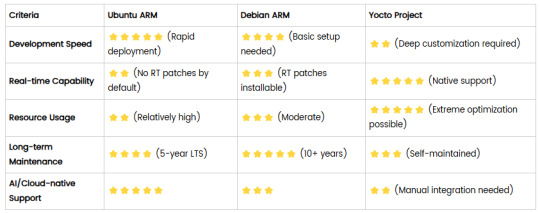
5. Selection Recommendations
Choose Ubuntu ARM: For rapid deployment of edge AI applications (e.g., vision detection on Jetson) or deep integration with public clouds (e.g., AWS IoT Greengrass).
Choose Debian ARM: For mission-critical industrial equipment (e.g., substation monitoring) where stability outweighs feature novelty.
Choose Yocto Project: For custom hardware development (e.g., proprietary industrial boards) or strict real-time/safety certification (e.g., ISO 13849) requirements.
6. Hybrid Architecture Example
Smart factory edge node:
Real-time control layer: RTOS built with Yocto (controlling robotic arms)
Data processing layer: Debian running OPC UA servers
Cloud connectivity layer: Ubuntu Server managing K8s edge clusters
Combining these systems based on specific needs can maximize the efficiency of IIoT edge computing.
0 notes